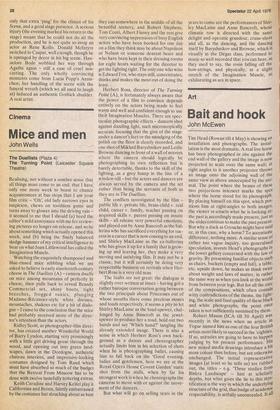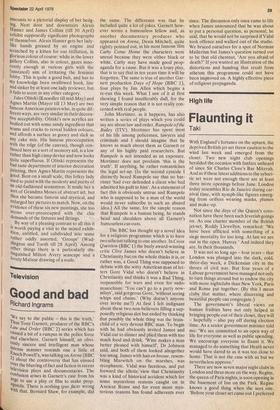Art
Bait and hook
John McEwen
Tim Head (Rowan till 4 May) is showing an installation and photographs. The installation is the most dramatic. A real live horse has been photographed in situ against the end wall of the gallery and the image is now projected to scale onto the same wall; at right angles to it another projector throws an image onto the adjoining wall of the same view as above unoccupied by the animal. The point where the beams of these two projections intersect marks the spot where the horse stood for its photograph. By placing himself on this spot, which positions him at right-angles to both images, the viewer re-enacts what he is looking at: the past is accordingly made present, just as the slides continue to make the past present. But why a duck as Groucho might have said or, in this case, why a horse? To accentuate difference, nothing more. A similar sense of rather too vague inquiry, too generalised speculation, invests Head's photographs 10 the lower gallery concerned with the law Of gravity. By presenting familiar objects such as chairs, buckets (empty and full), a table, etc, upside down, he makes us think twice about weight and laws of matter, in rather the same way as when you look at the world from between your legs. But for all the care of the compositions, which often contain witty contradictions of the theme, the lighting, the scale and final quality of these black and white photographs, the point once taken is not sufficiently sustained by their.
Robert Mason (ICA till 30 April) was recently in the news when an article 10 Vogue named him as one of the four British artists most likely to succeed in the 'eighties. If so, miracles are going to have to hapPe.n judging by his present performance. His new mixed media drawings introduce a bit more colour than before, but are otherwise unchanged. The initial representative images (at least so he tells us) are rubbed out, the titles — e.g. 'Three studies from Biskra Landscape' — hint at scholarly depths, but what gives the lie to this mYstification is the way in which the underlyin.g structure of the grid, that badge of academic respectability, is artfully unconcealed. It all amounts to a pictorial display of bet hedging. Next door and downstairs Alexis
Hunter and James Collins (till 30 April) exhibit supposedly significant photographs of themselves. Alexis Hunter gets her ladylike hands greased by an engine and scratched by a kitten for our titillation, in glorious colour of course: while in the lower gallery Collins, also in colour, gazes inno cently enough at various girls with the (unstated) aim of irritating the feminist lobby. This is quite a good bait, and has to my knowledge been swallowed hook, line and sinker by at least one lady reviewer, but it fails to score in any other category.
Jules Olitski (Knoedler till mid-May) and Agnes Martin (Mayor till 13 May) are two famous American painters who, in quite dif ferent ways, are very similar in their decorative acceptability. Olitski's new acrylics are bodied out with some sandy ingredient that seams and cracks to reveal hidden colours, and affords a surface as gooey and slick as any cake mix. His famous preoccupation With the edge (of the canvas), though continued here as a sort of memory aid, is a low rather than high camp device and now looks quite superfluous. If Olitski represents the bad taste department of interior decoration Painting, then Agnes Martin represents the good. Best on a small scale, this folksy lady used to paint with the modesty and purity of an old-fashioned seamstress. It made her a sort of Grandma Moses of abstract art, but then she became famous and mystical, and enlarged her pictures to match. Now, on the evidence of these six new paintings, she too seems over-preoccupied with the chic demands of the fixtures and fittings. By way of a pleasing contrast to all this it IS worth paying a visit to the mixed exhib
ition, entitled, and subdivided into some rather oddly assorted, 'Groups' (Waddington and Tooth till 28 April). Among ' Other things there is a particularly distinguished Milton Avery seascape and a lovely Matisse drawing of a nude.



































 Previous page
Previous page